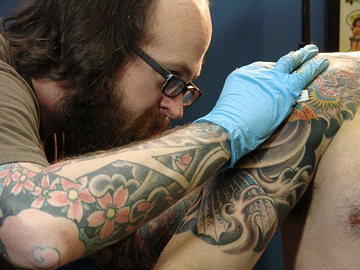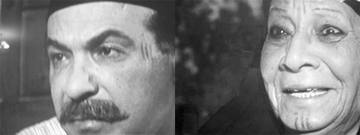
1. John MacIntyre Tattooing in Los Angeles
Inscribing The Body: Tattoos in Traditional and Modern Cultures
by el-Sayed el-Aswad
University of Bahrain
From ancient Egyptian culture, whence comes early evidence of tattooing, to contemporary art, the body has been employed as a living canvas for inscriptions and designs such as those of tattoos embodying symbols, icons, archetypes and mythological or folkloric themes. Tattoos, especially those consisting of lines and dots, have been found on preserved mummies, including that of Amunet, a priestess of the goddess Hathor at Thebes dating back to the XI Dynasty, 2000 B.C.E. Although amulets are widely used for protective, magical and ascetic purposes (and were predominantly used in ancient Egypt), they are replaceable or not permanent. Notions related to authenticity, ethnicity, gender, identity, sanctity, fertility, femininity, masculinity, class, and aestheticism, to mention a few, are inscribed permanently in various forms on the body.
Though tattooing is prohibited in Islam, because it is viewed as a factor in mutilating, maiming or altering the body’s physical features, local or traditional practices are still existent among the folk in various Muslim societies. For example, among the fellahin of Egypt, especially Upper Egyptians (Sa‘idi), tattoos (called washm in Arabic, but colloquially called daggah) can be identified with specific forms based mostly on gender, religion and locality. The gendered daggah takes different shapes, ranging from that of a little bird (‘asfura) to those depicted by a dot and/or three small lines. Men for example have the latter shape on their faces between their ear and the eye (see picture 2), while women prefer to wear the tattoo on their chins (see picture 2). It is worthy to note that these tattoo patterns of dots and lines are similar if not identical to those found on the mummy of Amunet. Furthermore, one wonders here if there a relationship between the tattoo patterns of bird (‘asfura), used by Upper Egyptians, and mythical Horus (depicted as falcon) in ancient Egypt. Furthermore, reflective of their religion, Copts prefer to have tattoos of the cross on their hands or arms.

2. Tattooing on Egyptian man, left, and woman, right
Moving from traditional societies to modern cultures one finds that tattooing, a reputable and profitable art has become trendy and popular among both men and women in different parts of the high-tech and sophisticated societies of the West (or US) and Japan. However, the full body art of the US and Japan differs from that of the small carefully placed icons or symbols of the rural Egyptian, although some western people may opt for simple line drawings or icons.
In November, this year, I conducted an interview with John MacIntyre, an innovative artist practicing tattooing in Los Angeles, to know more about the advancement of this global art (picture 1). He recounted that despite the fact that contemporary tattooing in modern culture is technologically advanced compared to traditional practices, most modern tattoo or body artists are still inspired by traditional, tribal patterns of tattoos.
John expressed his own experience as a tattooer as follows:
“While working in the field and obtaining a journeyman’s status I began to expand my knowledge of all forms of tattooing. Since a young age tribal and folk art has inspired me. I was also drawn to Asian art and pre renaissance European art. Images of fanciful beasts, threatening demons, and rich decorative motifs were of abundance in the tattooers’ repertoire. Through learning about another culture’s tattoo imagery, one can also gain insight into that culture, and what I have found is a limitless realm of study. Each year the diligent artist can expand his or her knowledge of our ever shrinking world. Also it may lend itself to preserving traditions in parts of the world that may drift into obscurity and extinction, if not for our new global awareness of the tattoo. I myself have witnessed change in peoples understanding of the tattoo. Once a thing of shame or rebellion, the tattoo is forging its way into a position of interest and respect amongst all walks of life. The tattoo has had its time amongst most people and on all inhabited continents, and from recent discoveries of the last decade in preserved mummies, we can see that it predates recorded history and may even have been around as man first expressed himself and decorated the walls of the cave with images of his existence. As an artist I am very proud to be part of a tradition that seems to have few bounds. I have been able to use imagery that would not be possible in most modern art forms. Also tattooing provides a level of autonomy for the artist that is seldom found. All work is done between two people, the tattooer and their customer. There are no art directors or committees to appease. A tattoo is also a very personal thing for the recipient, and to be able to give someone a piece of work that may help them in some way is an honor. Learning to tattoo is a humbling experience and the application of a permanent image on an others body is an operation that needs to be handled with serious intent. Not only is the craftsmen ship delicate but health concerns must be kept at the forefront of the procedure.â€